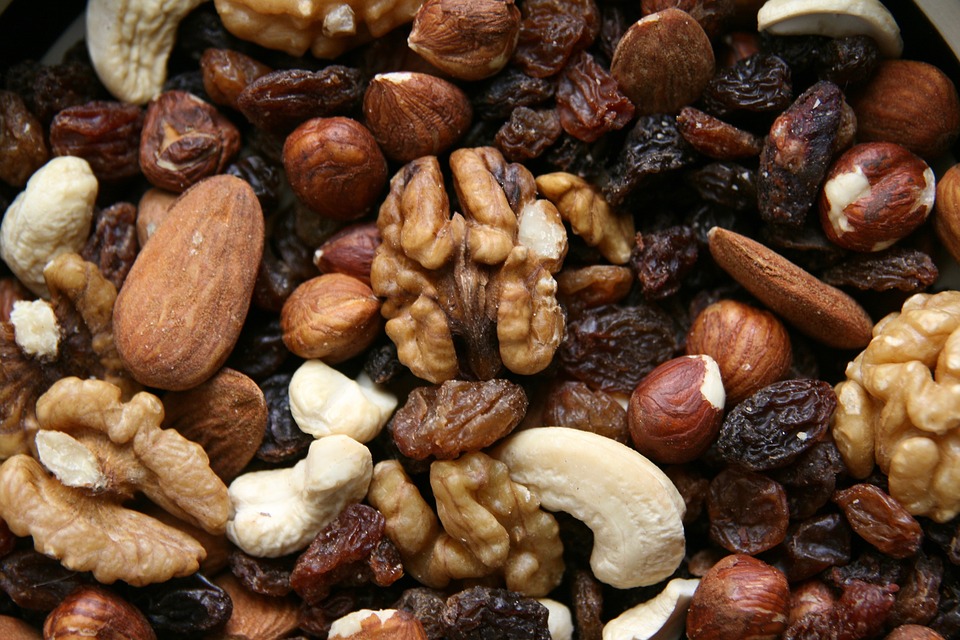Lesson 12
Writing and Graphing Systems of Linear Equations
- Let’s recall what it means to solve a system of linear equations and how to do it by graphing.
12.1: Math Talk: A Possible Mix?
Diego bought some raisins and walnuts to make trail mix.
Raisins cost $4 a pound and walnuts cost $8 a pound. Diego spent $15 on both ingredients.
Decide if each pair of values could be a combination of raisins and walnuts that Diego bought.

4 pounds of raisins and 2 pounds of walnuts
1 pound of raisins and 1.5 pounds of walnuts
2.25 pounds of raisins and 0.75 pounds of walnuts
3.5 pounds of raisins and 1 pound of walnuts
12.2: Trail Mix
- Here is a situation you saw earlier: Diego bought some raisins and walnuts to make trail mix. Raisins cost $4 a pound and walnuts cost $8 a pound. Diego spent $15 on both ingredients.
- Write an equation to represent this constraint. Let \(x\) be the pounds of raisins and \(y\) be the pounds of walnuts.
- Use graphing technology to graph the equation.
- Complete the table with the amount of one ingredient Diego could have bought given the other. Be prepared to explain or show your reasoning.
raisins (pounds) walnuts (pounds) 0 0.25 1.375 1.25 1.75 3
- Here is a new piece of information: Diego bought a total of 2 pounds of raisins and walnuts combined.
- Write an equation to represent this new constraint. Let \(x\) be the pounds of raisins and \(y\) be the pounds of walnuts.
- Use graphing technology to graph the equation.
- Complete the table with the amount of one ingredient Diego could have bought given the other. Be prepared to explain or show your reasoning.
raisins (pounds) walnuts (pounds) 0 0.25 1.375 1.25 1.75 3 - Diego spent $15 and bought exactly 2 pounds of raisins and walnuts. How many pounds of each did he buy? Explain or show how you know.
12.3: Meeting Constraints
Here are some situations that each relates two quantities and involves two constraints. For each situation, find the pair of values that meet both constraints and explain or show your reasoning.
-
A dining hall had a total of 25 tables—some long rectangular tables and some round ones. Long tables can seat 8 people. Round tables can seat 6 people. On a busy evening, all 190 seats at the tables are occupied.
How many long tables, \(x\), and how many round tables, \(y\), are there?
-
A family bought a total of 16 adult and child tickets to a magic show. Adult tickets are \$10.50 each and child tickets are \$7.50 each. The family paid a total of \$141.
How many adult tickets, \(a\), and child tickets, \(c\), did they buy?
-
At a poster shop, Han paid \$16.80 for 2 large posters and 3 small posters of his favorite band. Kiran paid \$14.15 for 1 large poster and 4 small posters of his favorite TV shows. Posters of the same size have the same price.
Find the price of a large poster, \(\ell\), and the price of a small poster, \(s\).
- Make up equations for two lines that intersect at \((4,1)\).
- Make up equations for three lines whose intersection points form a triangle with vertices at \((-4,0)\), \((2,9)\), and \((6,5)\).
Summary
A costume designer needs some silver and gold thread for the costumes for a school play. She needs a total of 240 yards. At a store that sells thread by the yard, silver thread costs \$0.04 a yard and gold thread costs \$0.07 a yard. The designer has \$15 to spend on the thread.
How many of each color should she get if she is buying exactly what is needed and spending all of her budget?
This situation involves two quantities and two constraints—length and cost. Answering the question means finding a pair of values that meets both constraints simultaneously. To do so, we can write two equations and graph them on the same coordinate plane.
Let \(x\) represents yards of silver thread and \(y\) yards of gold thread.
- The length constraint: \(x + y = 240\)
- The cost constraint: \(0.04x + 0.07y = 15\)
Every point on the graph of \(x+y=240\) is a pair of values that meets the length constraint.
Every point on the graph of \(0.04x + 0.07y = 15\) is a pair of values that meets the cost constraint.
The point where the two graphs intersect gives the pair of values that meets both constraints.

That point is \((60, 180)\), which represents 60 yards of silver thread and 180 yards of gold thread.
If we substitute 60 for \(x\) and 180 for \(y\) in each equation, we find that these values make the equation true. \((60,180)\) is a solution to both equations simultaneously.
\(\begin {align} x+y&=240\\ 60+180&=240\\ 240&=240 \end{align}\)
\(\begin{align} 0.04x + 0.07y &= 15\\ 0.04(60) + 0.07(180) &=15\\ 2.40 + 12.60 &=15\\ 15&=15 \end{align}\)
Two or more equations that represent the constraints in the same situation form a system of equations. A curly bracket is often used to indicate a system.
\(\begin {cases} x + y = 240\\0.04x + 0.07y = 15 \end {cases}\)
The solution to a system of equations is a pair of values that makes all of the equations in the system true. Graphing the equations is one way to find the solution to a system of equations.
Video Summary
Glossary Entries
- solution to a system of equations
A coordinate pair that makes both equations in the system true.
On the graph shown of the equations in a system, the solution is the point where the graphs intersect.
- system of equations
Two or more equations that represent the constraints in the same situation form a system of equations.
